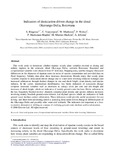Please use this identifier to cite or link to this item:
http://hdl.handle.net/10311/161| Title: | Indicators of desiccation-driven change in the distal Okavango Delta, Botswana |
| Authors: | Ringrose, S. Vanderpost, C. Matheson, W. Wolski, P. Huntsman-Mapila, P. Murray-Hudson, M. Jellema, A. |
| Keywords: | Semi-arid riparian zones Compositional and structural variables Water-table lowering Salinization |
| Issue Date: | Jan-2007 |
| Publisher: | Elsevier Ltd; www.elsevier.com/locate/jaridenv |
| Citation: | Ringrose, S. et al (2007) Indicators of desiccation-driven change in the distal Okavango Delta, Botswana, Journal of Arid Environments Vol 68, Issue 1, January, pp. 88-112 |
| Abstract: | This work seeks to determine whether riparian woody plant variables respond to drying and salinity regimes in the semi-arid distal Okavango Delta, northern Botswana. Structural and compositional variables were obtained from 47 field sites. Mapping using satellite imagery illustrated differences in the character of riparian zones in terms of species composition and provided data on flood frequency. Salinity data plots show increases downstream. Results imply that woody plant variables respond to desiccation-driven change due to water-table lowering (reduced recharge) and increased salinization through distinct changes in tree and shrub height, plant density and species richness. In the wetter, intermediate distributaries, key biotic indicators of ecosystem change comprise structural variables such as decreases in canopy cover per cent and tree height and increases of shrub height, which are indicative of mainly ground-water declines. Biotic indicators in the less frequently flooded receiver channels comprise plant density and species richness increases involving mainly brackish ground-water-tolerant and dryland species which are indicative of both ground-water declines and/or salinization. These indicators could provide useful parameters for use in long- and short-term monitoring aimed at assessing desiccation-driven change in different parts of the Okavango Delta and possibly other semi-arid wetlands. The indicators are important as a less-expensive alternative to drilling as a means of verifying ground-water declines and/or salinization. |
| URI: | http://hdl.handle.net/10311/161 |
| ISSN: | 0140-1963 |
| Appears in Collections: | Research articles (ORI) |
Files in This Item:
| File | Description | Size | Format | |
|---|---|---|---|---|
| Ringrose_et_al_JAE_07.pdf | 1.29 MB | Adobe PDF |  View/Open | |
| license.txt | 1.95 kB | Text | View/Open |
Items in DSpace are protected by copyright, with all rights reserved, unless otherwise indicated.
